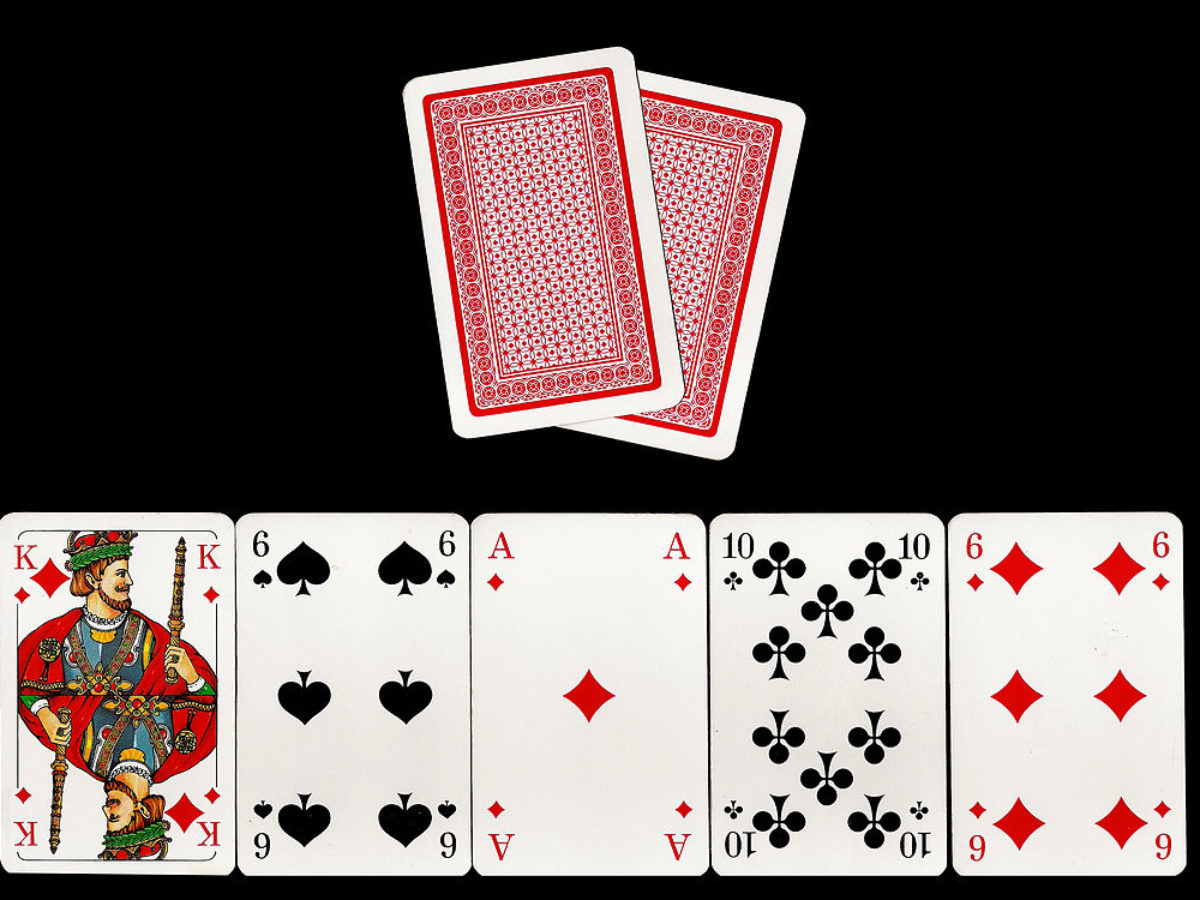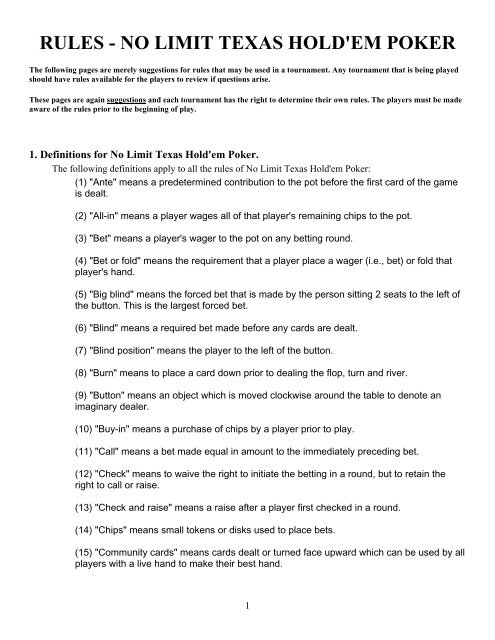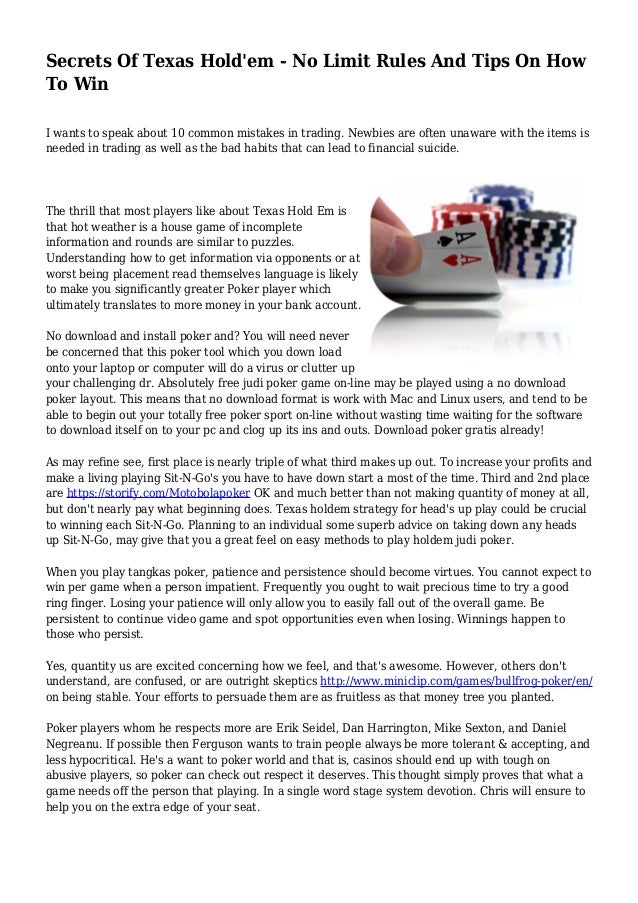No Limit Texas Holdem Rules
- Texas Holdem No Limit Betting Rules
- Official No Limit Texas Hold'em Rules
- No Limit Texas Holdem Rules
- No Limit Texas Hold'em Strategy
- No Limit Texas Holdem Raising Rules
- No Limit Texas Hold'em Rules

In a game of no-limit Texas hold'em, the minimum opening raise must be at least twice the big blind, and the maximum raise can be all of the chips a player has in his or her stack (an 'all-in'.
- No limit Texas Hold’em Poker is considered one of the purest forms of the game. The size of the blinds in a No Limit game are stated in the name. A $2/$4 no limit game’s small blind is worth.
- Texas Hold’em Rules In Texas hold’em each player is dealt two cards called their ‘hole’ cards. Hole cards can only be seen and used by one person.
The Texas Holdem version of poker is one of the easiest to learn. It is for this reason that it has now become the most popular poker variant both online and in casinos.
The simplicity of the rules allows new players to pick up the game and start playing after a few minutes, whilst the depth of the game helps keep players interested for years. This guide aims to give you a complete understanding on how Texas Holdem is played, and it will take no longer than 5 minutes.
Texas Hold'em rules basics.

Texas Holdem is played with a 52-card deck and poker chips. Texas Holdem can be played in a cash game style, where there is no time limit and each hand is played with real money.
The game can also be played in a tournament style where each player receives a set amount of chips at the start, and the winner is the player that obtains all of the chips on the table. Tournaments can also be played for real money, where the winner takes all or part of the other players’ buy-ins.
- Each player is dealt two cards face down on the table, these are called 'holecards'.
- 5 community cards are dealt face up in the middle of the table in 3 separate stages.
- The Flop is the first stage, where the first 3 cards are dealt face up.
- The Turn is the second stage, where 1 card is dealt up.
- The River is the final stage, where 1 last card is dealt face up.
- Players use a combination of the 2 cards in their hand and the 5 cards on the table to make the best 5 card hand (see Texas Hold'em hand rank).
- At each stage there is a round of betting.
- If there are still players left in the hand after the final round of betting, the hand will go to a ‘showdown’ and the best hand will take the money in the pot.
Texas Hold'em betting.
Betting is a fundamental part of poker. The amount you can bet depends of the variant of Texas Holdem you are playing.
- In Limit Holdem you can only bet a fixed amount on each round.
- In Pot Limit Holdem you can bet any size you wish up to the amount that is already in the pot.
- In No Limit Holdem you can bet any amount of money on any round up to the amount you have in front of you.
There are numerous stages in the game of Texas Holdem where betting can take place.
Sequence of rounds and betting.
Holecards are dealt
Round of betting
Flop is dealt
Round of betting
Turn is dealt
Round of betting
River is dealt
Round of betting
In each of these rounds of betting, you will have 3 options available to you depending on what has happened before the action reaches you. The two situations you will be in are acting after there has been a bet, or acting after no bets have been made. (See the bet sizing article for betting strategy in Texas Hold'em.)
Acting after no bets.
- Check – By ‘checking’ you do not put any money in the pot, and the next card will be dealt if no other bets are made.
- Bet – By betting you put money into the pot. This means that the other players must call this bet to see the next card to be dealt.
- Fold – You also have the option to fold, but this is rarely done because it is currently free for you to see another card and give yourself an opportunity to make the best hand.
Acting after a bet.
- Call – By calling, you put the same amount of money into the pot that the other player has bet. Therefore you will see the next card if no other players raise this bet.
- Raise – You can raise another player’s bet and force them to call an additional amount of money for them to see the next card.
- Fold – If you do not wish to put more money into the pot, you can fold your hand. Your hand will be declared 'dead' and you will no longer be able to win the money in the pot.
Dealing in Texas Holdem.
The cards in Texas Holdem have to be dealt in accordance to a simple set of rules. These rules help to keep the dealing fair, and prevent the cards from being fixed.
- Holecards must be dealt 1 at a time from the top of the pack in a clockwise motion starting from the dealer’s left.
- Before the flop can be dealt, a card must be 'burned' which means that this card is dealt face down on the table and placed to one side.
- Before the turn, another card must be 'burned'.
- Before the river, one final card must again be 'burned'.
Texas Hold'em rules overview.
As you can hopefully see, Texas Holdem is a very simple game to pick up. It is also a very enjoyable game and can be played for real money or for entertainment purposes without the use of money. Due to the betting nature of the game, it is possible to learn skills and strategies to improve the way you play and win money through playing poker. If you want to be able to win money through poker, we have a strategy section with numerous strategy guides to help you improve your poker game.
Now go out and start playing some Texas Holdem. Don't forget to brush up on the Hold'em hand rank (try the hand rank quiz for some extra help) before you play to ensure that you know what beats what.
Go back to the interesting Texas Hold'em Articles.
Can You Afford Not To Use
Poker Tracker 4?
“I wouldn’t play another session of online poker without it”
“I play $25NL, and in under 1 week PT4 had paid for itself”
Comments
If I were teaching a new player to play no-limit hold’em, and my goal were to get this player up to a professional level of play, how would I do it? What would my lessons look like?

Let’s say I had only three months to do it. With most people, I will admit, it would be a tall order. The learning curve is steep these days, and I don’t think everyone could make it from zero to pro in that short a time.
I’d have to make compromises. I couldn’t try to cover every possible situation. I’d have to find the important bits and skip the rest.
I’d also have to tailor the lessons a bit to a specific type of game. The most important skills in some game types are not as important in others. With this in mind, here are what I think my top five lessons would be for a new player trying to beat the $2-$5 no-limit hold’em games in Las Vegas.
Lesson No. 1. Don’t limp into pots ever. And don’t call preflop three-bets unless you are trapping with an ultra-premium hand.
Limping into pots, calling the preflop raise, and then check/folding the flop when you miss is an enormous leak. It’s also one that nearly every player who hasn’t been specifically coached out of it exhibits.

In my opinion, most players would see an immediate improvement in their winrates if they simply refused to limp in with any hand, especially if they chose to instead fold most of these hands.
For most players, refusing ever to limp means playing much tighter, particularly from out of position. Until you’re already an established pro player, tighter is better.
Lesson No. 2. Don’t pay off big turn and river bets.
This lesson might be different in some types of games, but in the Las Vegas $2-$5 games, it’s easily a candidate for the single most important piece of advice. Do not pay anyone off. When someone makes a big turn or river bet or raise, your one pair hand (or whatever other hand you’re thinking about calling with) is a bluff-catcher. That means, in the great majority of cases, your opponent won’t be trying to make a value bet with a worse hand. Either you’re beat or your opponent is bluffing. And players in these $2-$5 games do not bluff often enough to make calling worthwhile.
Texas Holdem No Limit Betting Rules
So you don’t pay off. I know it can be frustrating to feel like you’re getting muscled out of a huge pot, but the fact is, most players in these games do very little muscling. They try to make hands, and then they bet the hands they make. A big bet usually means a big hand. You don’t need to call to find out for certain.
Lesson No. 3. Your opponents will limp into pots, call raises, and check/fold flops. Take advantage of this weakness by raising lots of hands with position, betting the flop, and often also betting the turn.
It’s a simple play, but it’s one that generates a very consistent profit in these games. Players play too loosely preflop, are too willing to call preflop raises after limping in, and are too willing to check/fold the flop or turn if they miss. With many players, you can ignore your cards and raise the limps, bet nearly all flops, and bet most turn cards as well.
Say two typical players limp in a $2-$5 game. You raise to $25 on the button. Both limpers call.
The flop comes 10 8 2. They check, and you bet $50. One player calls.
The turn is the 5. Your opponent checks, you bet $120, and he folds.
In this scenario, and in many like it, it doesn’t matter what you have. Your opponents are beating themselves by playing call/call/fold so often. All you have to do is put the bets out there and let your opponents run repeatedly into the brick wall.
Yes, there is some nuance to this, and some boards are better bets than others. But against many opponents at the $2-$5 level, most flops, turns, and even rivers are good bets. Keep betting until your opponents prove to you that they won’t beat themselves by folding too much.
Lesson No. 4. With value hands, don’t try to blow opponents out of pots. Instead, play most value hands with the goal of keeping a player in through the river.
Official No Limit Texas Hold'em Rules
Value hands — hands like top pair, two pair, or any other hand you think is a favorite to be best — lose their value when all your opponents fold. If you win without a showdown, you might as well have been holding 7-2. (See Lesson No. 3.) With your value hands, you generally want opponents to get to the river.
Most players like to see showdowns if they feel like they can see them without losing too much money. No one likes to fold and think, “What if I was good?” If your opponents get to the river, often it’s an easy sell to get them to call a final value bet (as long as you don’t make it too big).
Calling these value bets is one of the biggest mistakes that $2-$5 players make. (See Lesson No. 2.) Allow your opponents to make this mistake.
Most players try to end hands early when they feel like they have the best hand. “Don’t want to get drawn out on,” they think. But this is backward thinking. End hands early with strong bets when you have nothing but a weak draw. Allow hands to reach showdown when you actually have something to show down! (Makes sense when I put it that way, doesn’t it?)
If I have top pair, I’d much rather get called for $30, $50, and $80 on flop, turn, and river than get called for $30 and then blow my opponent out of the hand with a $100 bet on the turn. The chance to win $160 with the hand instead of $30 outweighs the risk that I’ll get outdrawn.
No Limit Texas Holdem Rules
Lesson No. 5. Think every hand about what strategies your opponents are using and how they’re thinking, and (almost) ignore the two cards in your hand.
I’ll put it bluntly. Most $2-$5 players beat themselves. They tend to play strategies that are extremely transparent, overly simplistic, and inflexible. You can beat some of these players simply by betting every time it’s your action (See Lesson No. 3.) You can beat other of these players simply by waiting for hands that beat top pair/no kicker and then making value bets. (See Lesson No. 4.)
No Limit Texas Hold'em Strategy
Your job as a poker player is to identify the strategy each opponent is using and deploy a counter strategy. In many cases, the two cards in your hand become irrelevant. My experience is that the players that are always thinking about their hands never figure it out. It’s the players who are thinking on the next level that do. ♠
No Limit Texas Holdem Raising Rules
Ed’s newest book, Playing The Player: Moving Beyond ABC Poker To Dominate Your Opponents, is on sale at notedpokerauthority.com. Find Ed on Facebook at facebook.com/edmillerauthor and on Twitter @EdMillerPoker.